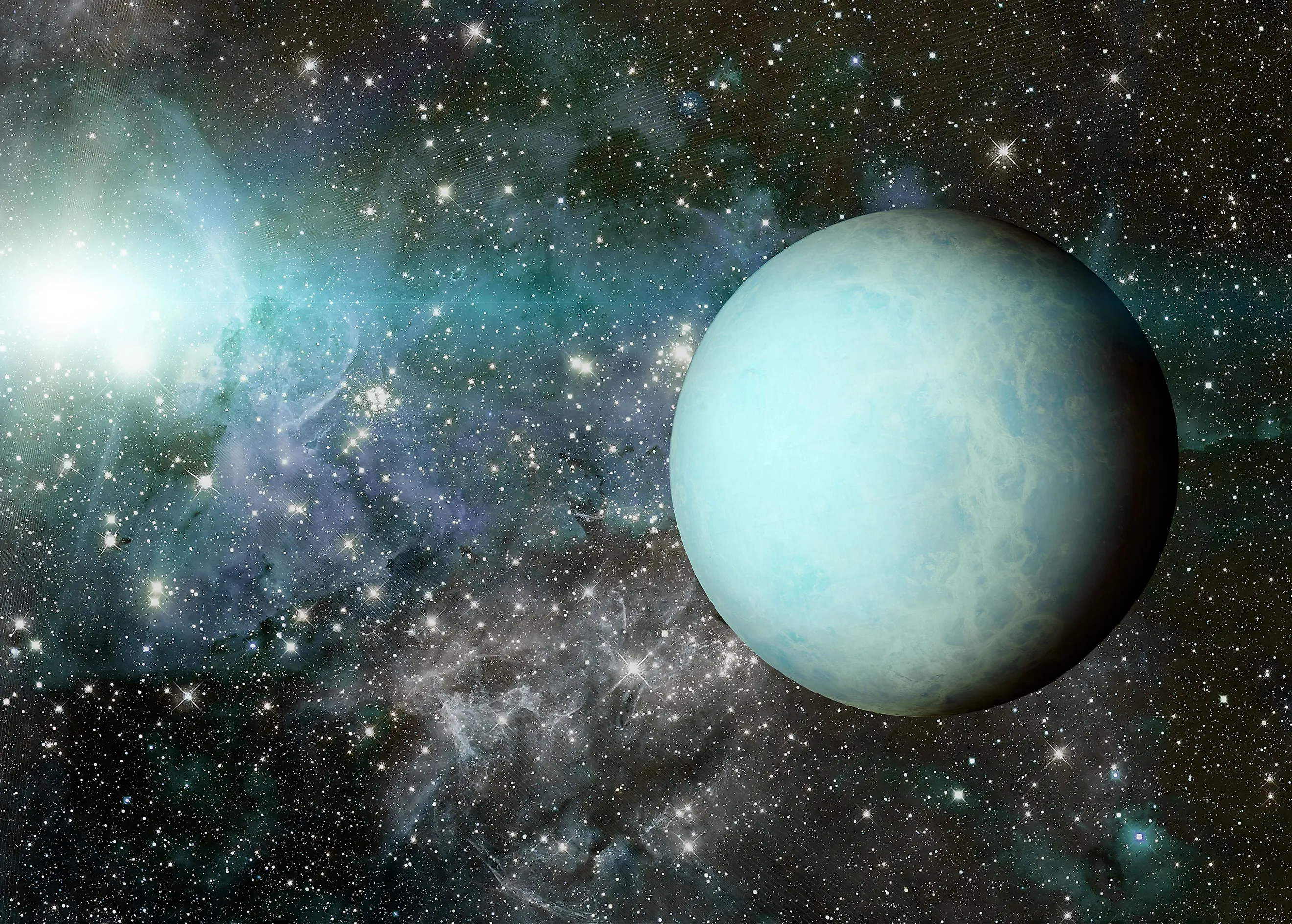
Uranus
Uranus is the third-largest planet by size and the fourth largest by mass in the solar system. Uranus has a diameter of roughly 37,673 miles (55,800 kilometers) and is about 14.5 times the mass of Earth. Uranus is the seventh furthest planet from the sun, averaging over 1.8 billion miles (2.9 billion kilometers) away from the sun.
It takes Uranus 84 years to orbit the sun and 17 hours to rotate about its axis. Uranus is also the coldest planet in the solar system, having a minimum temperature of minus 371 degrees Fahrenheit ( minus 224 degrees Celsius). Most of the planets in the solar system are visible to the naked eye. No equipment is required to see the first six planets in our solar system. Thus, the planet Uranus was unknown to ancient cultures, having been discovered in the 1700s.
On March 13, 1781, the astronomer William Herschel became the first person to recognize Uranus as another planet in our solar system. For the first time in human history, the number of known planets in the solar system increased. Despite being discovered over 240 years ago, virtually everything about Uranus was a mystery. Two main factors make Uranus a challenging world to observe and study in detail: Uranus's distance and dimness. Uranus orbits the sun at an average distance of 1.8 billion miles (2.9 billion kilometers), and so it receives very little sunlight compared to the other planets. So not only is Uranus exceptionally far away, but it is also very dim and hard to see without a powerful telescope. Most of what is known about Uranus comes from the Voyager 2 flyby of Uranus in 1986, which not only offered scientists with the first up-close images of Uranus, but also revealed the planet's composition, density, and moons.
Observational History Of Uranus
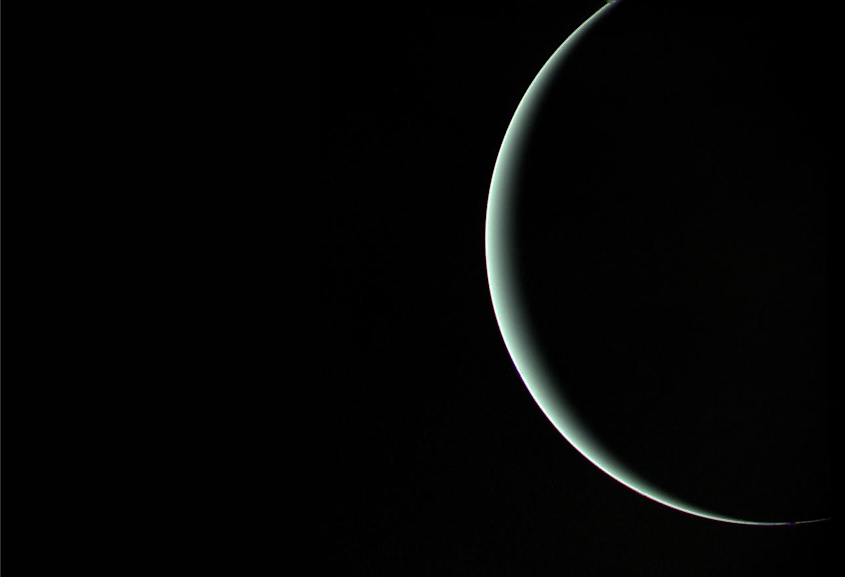
The observational history of Uranus is an interesting one. Uranus cannot be seen with the naked eye for the most part. However, it is possible to see Uranus at some points in its orbit so long as there is no light pollution. Given how far away and dim Uranus is, it would be difficult to differentiate it from a star. Interestingly, evidence suggests that the ancient Greeks and Romans may have observed Uranus. Since the planet moves so slowly, however, they would not have been able to notice it was a planet and not a star. In the 1600s, astronomers cataloged Uranus as a star. In 1781, the astronomer William Herschel began a series of observations of Uranus, which he believed was a comet rather than a star. When Herschel announced that this object was a comet, other astronomers began suspecting that he had discovered an entirely new planet. By 1783, Uranus was widely accepted by the astronomical community to be a planet.
Naming Uranus was a lengthy process. Since William Herschel discovered it, he also got to name it. Oddly enough, Herschel decided to name the new planet after King George III, and the new planet became known as George. Most astronomers were not overly fond of calling the new planet George, and many other names were proposed. After years of debate, one of the proposed names was chosen. To keep with the tradition of naming the planets after mythological characters, scientists named the new planet Uranus after the Greek god of the sky and the father of the Titans. Most of what is known about Uranus would be revealed during the Voyager 2 flyby in 1986. As of yet, Voyager 2 is the only spacecraft to visit Uranus.
Orbit And Rotation Of Uranus
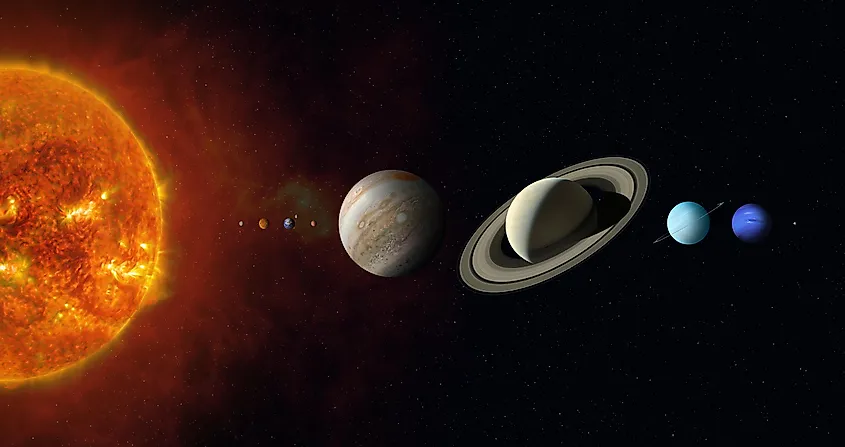
Since Uranus orbits the sun at a distance of 1.8 billion miles (2.9 billion kilometers), it takes the planet many decades to complete one orbit around the sun. It takes Uranus approximately 84 Earth years to orbit the sun. Uranus has completed nearly three orbits since its discovery. In fact, in 2033, Uranus will complete its third orbit since it was discovered in 1781. Uranus's orbit is the most elliptical of all the planets in the solar system. The distance between Uranus and the sun changes by a greater distance than any other planet. During its closest approach, Uranus will reach a distance of 1.7 billion miles (2.5 billion kilometers) from the sun. During its farthest approach, Uranus is 1.9 billion miles (three billion kilometers) from the sun. The difference between its farthest and closest approaches is the largest of any planet in the solar system.
The rotation of Uranus is one of the strangest in the solar system. For the most part, every planet in the solar system rotates counterclockwise about its axis. There are two exceptions to this rule: Venus and Uranus. In the case of Uranus, the planet would appear to rotate counterclockwise if it were pointing in the right direction. However, Uranus has been tipped over on its side. Rather than rotating from side to side, Uranus rotates from top to bottom, almost like a wheel. In a way, Uranus rolls around the sun. This is because Uranus has the most extreme axis tilt in the solar system, with its axis being tilted by 97.7 degrees. This extreme axis tilt causes Uranus to experience some interesting seasonal changes. During one half of its orbit, one side continually faces the sun, and during the other half, that same side will continuously face away from the sun. Each side of Uranus will experience 42 years of sunlight and 42 years of darkness. Unlike all the other planets, the equator of Uranus experiences the least amount of sunlight of all the regions on the planet. Interestingly, this would suggest that the equator is colder than the rest of the planet, yet it's noticeably warmer. The exact reasons for this remain a mystery, yet it is likely due to some convection process occurring within the interior of Uranus.
Although the exact explanation for why Uranus is tilted by over 97 degrees is a mystery, the most likely explanation is that Uranus experienced a collision with another planet at some point in its history, causing the entire planet to tip over. During the early days of the solar system, it's likely that over a hundred planets formed out of the protoplanetary disk. The vast majority of these planets collided with one another and formed larger planets. Around four billion years ago, Uranus was likely impacted by an Earth-sized world. The collision caused Uranus to tip over on its side, resulting in the most extreme axis tilt of any planet in the solar system.
Uranus's Atmosphere
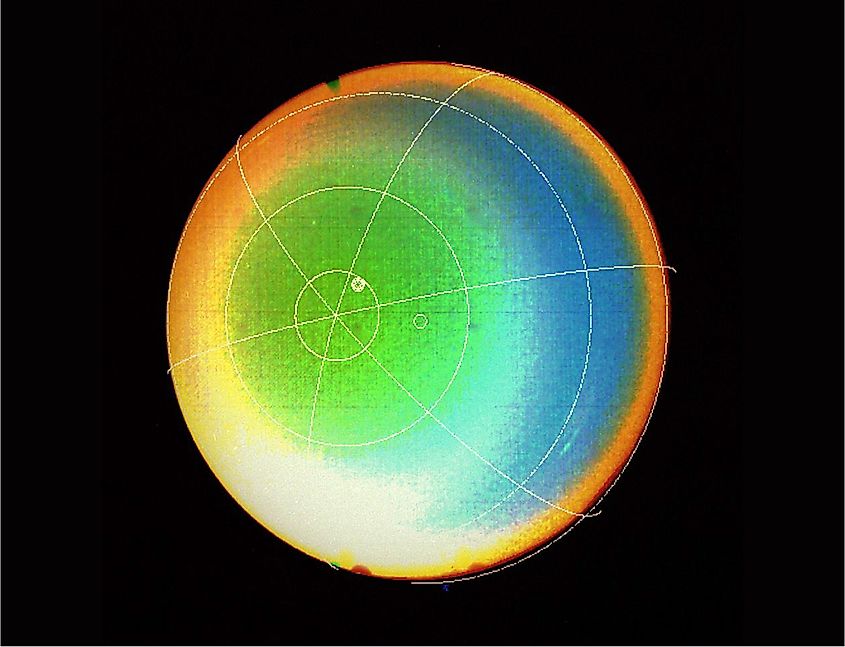
Like Jupiter and Saturn, Uranus is a gas giant planet primarily composed of hydrogen and helium. However, despite being defined as a gas giant, the overall composition of Uranus is noticeably different from Jupiter and Saturn. Uranus (and also Neptune) contains a much higher abundance of ice made of water, methane, and ammonia. Uranus is classified as a gas giant, but it is also classified as an ice giant. What makes Uranus an ice giant is that ice makes up most of the planet's mass. Although hydrogen and helium make most of Uranus's composition, they are also the two lightest elements in the universe. So they make up a very small portion of Uranus's total mass. The mass of Uranus is about 14.5 Earths, with anywhere from 9.3 to 13.5 Earth masses being in the form of various ices.
Like the other gas giants, Uranus has no well-defined surface. As of yet, it is not known whether or not Uranus even has a solid surface. It could simply be gas all the way through, or there could be a rocky core. Without a defined surface, it's challenging to determine where the atmosphere of Uranus begins. Astronomers generally define the atmosphere of Uranus to be the area that can be detected through remote sensing. For Uranus, this extends roughly 300 kilometers into the planet. The atmosphere of Uranus is divided into two separate layers: the troposphere and the stratosphere. The troposphere is the lowest region of Uranus's atmosphere, and it also has the highest density. The troposphere is a very cold region of the atmosphere, having an average temperature of roughly minus 353 degrees Fahrenheit (minus 214 degrees Celsius). Clouds are likely a common feature in the troposphere, with colder temperatures allowing for the formation of methane clouds, ammonia clouds, and hydrogen sulfide clouds. The stratosphere contains a much higher abundance of hydrogen and helium, yet it still contains ices such as water and methane. The methane in the upper atmosphere gives Uranus its bluish tinge. Methane absorbs incoming red light from the sun and scatters blue light.
Internal Structure Of Uranus
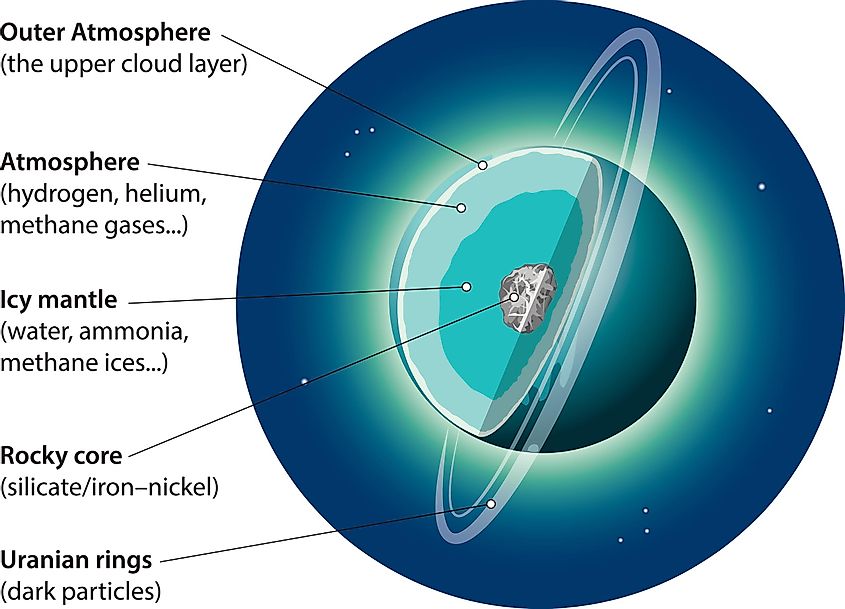
The interior of Uranus is essentially a mystery, as no spacecraft has ventured into the planet. The only mission to Uranus was the Voyager 2 flyby, and it was only able to observe the atmosphere. However, observations from telescopes such as Hubble have uncovered some evidence of what is occurring within Uranus. It is generally believed that Uranus is divided into three layers: an atmosphere, a mantle, and a rocky core. Regarding its core, Uranus is believed to have a rocky center and an estimated mass of 0.55 Earths. Compared to the rest of Uranus, the core is small, comprising less than 20% of the planet's total radius. The mantle makes up the majority of Uranus, and it truly is an interesting place. Pressures and temperatures in the mantle are so high that it causes methane molecules to break apart. The carbon atoms that break off from the methane condense into diamonds and fall through the mantle. On Uranus, diamonds fall like hail. Experiments on Earth further suggest that the mantle may contain an ocean of liquid carbon, wherein large structures of diamond float freely across the mantle. Scientists refer to these diamond structures as diamond-bergs.
Given its distance from the sun, it is no surprise that Uranus is a dry cold planet. However, what is surprising is just how cold it is. Uranus is colder than Neptune, even though it is significantly closer to the sun. Unlike the inner rocky worlds, the gas giants primarily receive heat from internal processes rather than the sun. Generally, the gas giants will release more energy into space than they receive from the sun. Uranus, however, is an exception to this rule. While Neptune releases over twice as much heat into space than it receives from the sun, Uranus emits very little excess heat into space. Uranus is the coldest planet in the solar system, with the coldest temperature ever recorded being minus 371 degrees Fahrenheit (minus 224 degrees Celsius). The exact reasons behind Uranus's colder temperatures are a mystery, yet one explanation has to do with the possible impact that tipped the planet over many billions of years ago. The impact that caused Uranus to have its current axis tilt may have also caused the planet's interior to lose most of its heat. Another possible explanation is that Uranus contains some barrier preventing heat from the interior from escaping into space.
Uranus's Moon System
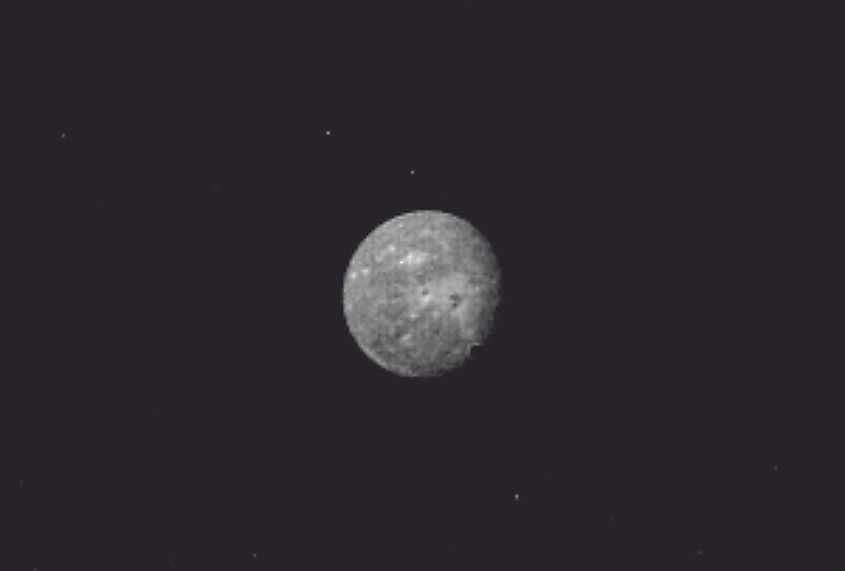
Uranus is home to the third-largest moon system in the solar system. Uranus has 27 known moons, all of which are named after characters from Shakespearean plays and Alexander Pope poems. Interestingly, despite Uranus having more moons than Neptune, the combined mass of all its moons is significantly less than Neptune's, making the moon system of Uranus the least massive of all the gas giants. Of its 27 moons, three are worth noting: Titania, Oberon, and Miranda.
Titania is the largest moon of Uranus and the eighth largest moon in the solar system overall. Titania has a diameter of about 981 miles (1,578 kilometers) and orbits Uranus at 271,000 miles (436,000 kilometers). It takes Titania approximately 8.7 days to orbit Uranus. Like most moons, the surface of Titania is covered in impact craters, yet the moon surprisingly lacks craters from the early days of the solar system. This suggests that Titania may have been geologically active in the distant past, and it likely experienced a large-scale resurfacing event that eroded its oldest craters. Titania is composed mainly of rock and ice.
Oberon is the outermost of the five main moons of Uranus, and it is also the second-largest moon of Uranus. Oberon is very similar to Titania, as both are composed of nearly the same stuff. Oberon is composed of equal parts ice and rock. Oberon orbits Uranus at a distance of 584,000 kilometers, and it takes the moon about 13.5 days to orbit Uranus.
Miranda may not be the largest moon of Uranus, but it is probably the most interesting. Miranda is the smallest and innermost of the five main moons, yet its surface is unlike anything else in the solar system. Miranda is only 470 kilometers across, yet it has become one of the most intensely studied moons in the solar system. That's because the surface of Miranda is one of the most varied and extreme of any object in the solar system. Miranda is even home to one of the largest cliffs in the solar system, a structure named Verona Rupes, which stands at over 20 kilometers in height. Since Miranda has only ever been seen by the Voyager 2 spacecraft, much of this moon remains a mystery. Miranda orbits Uranus at 129,000 kilometers, resulting in an orbital period of only 34 hours.
Rings Of Uranus
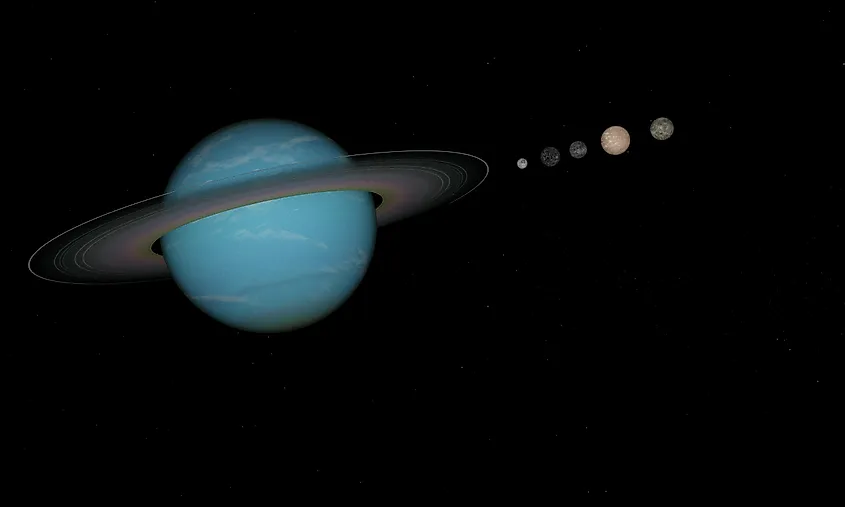
Like the other gas giants in our solar system, Uranus has a system of rings. So far, scientists have uncovered 13 rings around Uranus. The rings of Uranus are the second largest in the solar system after Saturn's. Unlike Saturn's rings, however, the rings of Uranus are exceedingly dark and hard to see. Saturn's rings are primarily composed of ice, reflecting sunlight. However, the rings of Uranus appear to be composed of much darker material, likely rock, and organic compounds. Evidence suggests that the rings did not form alongside Uranus and are likely a relatively recent addition to the planet. It is generally believed that the rings were once a moon that moved too close to Uranus, with the planet's gravitational pull ripping the moon apart. The debris would have entered orbit and formed a system of rings.
Uranus Fact Sheet
| Diameter | 31,673 miles (55,800 kilometres) |
|---|---|
|
Mass |
14.5 Earths |
|
Moons |
27 |
|
Rings |
13 |
|
Distance from the sun |
1.8 billion miles (2.9 billion kilometres) |
|
Length of year |
30,685 Earth days (84 years) |
|
Length of day |
17 hours |
|
Surface temperature |
Minus 365 degrees Fahrenheit (minus 220 degrees Celsius) |
|
Atmospheric composition |
82% hydrogen, 15% helium, 2% methane |
|
Surface composition |
Ammonia, water, methane, hydrogen, helium |
|
Discovery date |
March 13, 1781 |
|
Discovered by |
William Herschel |











